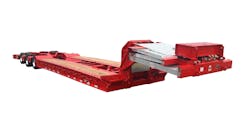Talbert Manufacturing introduced its 50-Ton Bus Hauler (50CC-BH) trailer that gives customers enhanced versatility. Talbert designed the trailer with an in-deck winch so users can load equipment from either the front or rear of the trailer. The 50CC-BH boasts a 50-ton capacity rating for hauling a wide range of oversized equipment, including buses, excavators and class A trucks.
“This trailer is ideal for our customers that haul a variety of equipment. These customers face a wide range of challenging requirements, including the need to load pieces with low approach angles, such as buses,” said Troy Geisler, Talbert vice president of marketing and sales. “We designed the 50CC-BH to accommodate that need, giving this customer base a safe and cost-effective way to achieve that.”
Talbert designed the 50CC-BH with extra steel in the main and side beams of the deck as well as the gooseneck and rear axles. According to the company, this design allows the trailer to achieve its 50-ton capacity rating without significantly increasing its weight.
The trailer features rollers and a snatch block that allow users to pull equipment from either end of the trailer using the 20,000-lb. planetary in-deck winch. Customers can operate the winch via remote control, which eliminates the need for additional people when loading inoperable equipment.
The 50CC-BH is equipped with three close-coupled axles and features a 22-ft. 6-in. lower deck length, plus a 20-ft. 5-in. rear bridge, creating a 43-ft. load base, which provides ample space for hauling large equipment. The trailer has a 21-in. deck height and a 24-in. flip-up gooseneck that increases the unit’s 84-in. swing radius to 108 in. This allows the unit to be used with both three- and four-axle trucks and keeps the trailer within the 53-ft. overall length limit when running empty, saving permit costs.
Talbert offers the 50CC-BH with heavy-duty10-foot removable aluminum ramps, which can be stored in compartments at the trailer’s gooseneck. The 50CC-BH is designed with a low front and rear load angle, for loading large, low-profile equipment.
About the Author
Fleet Owner Staff
Our Editorial Team
Kevin Jones, Editorial Director, Commercial Vehicle Group
Cristina Commendatore, Executive Editor
Scott Achelpohl, Managing Editor
Josh Fisher, Senior Editor
Catharine Conway, Digital Editor
Eric Van Egeren, Art Director
